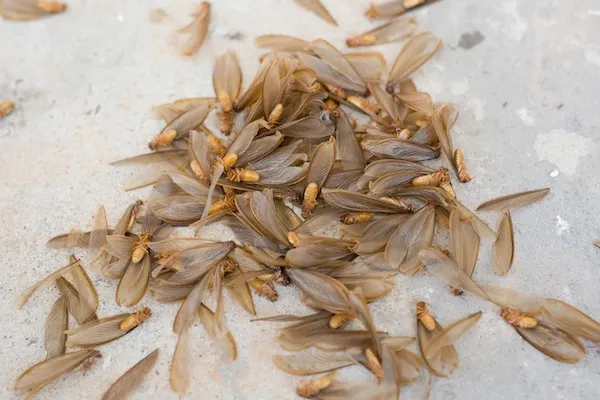Termites, the silent destroyers of homes, aren’t the favored houseguest for many Missouri residents. These pests can wreak havoc on a home’s structure, often operating stealthily for extended periods without detection.
Learning about termite behavior is a crucial step toward preventing these pests from invading your home. So, when do termites swarm, and what implications does that hold?
Continue reading to discover the primary signs of a termite infestation and understand the potential impact on your home. Plus, don’t forget that Absolute Pest Control is your go-to company for termite inspections and eradication in the Kansas City Metro!
Swarming Seasons for Termites
Termite swarming marks a critical stage in their life cycle. During this period, winged termites venture out from their existing colonies to initiate new ones. Once a female termite finds a suitable mate, it sheds its wings and establishes a new colony.
These mating flights ensure the survival and expansion of the species. By dispersing to new locations, termites reduce the risk of inbreeding and increase their chances of establishing successful colonies elsewhere on your property.
Once termite colonies take hold, they have the potential to expand quickly, resulting in significant structural damage to homes if not promptly addressed. Swarming serves as a means for termites to spread to new areas, ensuring their continued existence and the perpetuation of their life cycle.
When Do Termites Swarm in Missouri?
Typically, termite swarms in Missouri occur in spring, notably between March and May, coinciding with rising temperatures and heightened humidity. However, these swarming events might also occur during the fall months, specifically in September and October, influenced by various environmental elements.
Moisture plays a crucial role in the survival and reproduction of termites. Missouri experiences weather fluctuations in both spring and fall, characterized by intermittent rainfall and varying temperatures, creating an ideal habitat for termite activity. These conditions encourage termites to depart from their established colonies for fresh nesting sites.
In addition to environmental factors, the prevalent termite species in Missouri significantly impact their swarming behavior. Among the most common types found in the state are subterranean termites, which establish colonies underground and rely on soil contact to maintain necessary moisture levels for survival.
Detecting Termite Swarming Activity
Spotting early signs of termite swarming can make the difference between a minor annoyance and a severe infestation.
Look out for discarded wings around windowsills, doorways, or entry points, often indicating recent termite activity.
Additionally, keep an eye on your home’s foundation and walls for mud tubes, which termites use as sheltered paths. The presence of these tubes is a strong indication of active termite infestation.
Regularly checking for these signs can help catch termite issues early and save your home from further damage. If you notice any of these signs, immediately contact a trusted pest control company, like the experts at Absolute Pest Control.
Proactive Measures Against Termite Swarming
Conducting routine inspections performed by pest control professionals is a proactive step toward termite prevention. Take a look below at the many avenues a pest control professional can help keep your home protected:
Professional Inspection and Treatment
Regular inspections can swiftly identify burgeoning termite activity before it escalates. Trained professionals can detect signs of infestation early and implement suitable treatment plans tailored to the specific needs of your property.
Soil Treatment and Barrier Methods
Applying liquid termiticides to the soil around your property acts as a barrier, deterring termites from approaching the structure.
Baiting Systems
Baiting systems strategically placed around your property can effectively control termite populations. These systems use bait stations containing cellulose material and slow-acting toxins. Termites feed on the bait and transfer the toxin to others, gradually reducing the colony’s population.
Moisture Control and Home Maintenance
Eliminating moisture sources in and around your home is crucial in termite prevention. Ensure proper drainage, promptly fix leaks, and divert water from the foundation. Regularly inspect wooden structures for decay and maintain a gap between soil and wooden portions of your home.
Regular Monitoring and Follow-Ups
After implementing preventive measures, regular monitoring and follow-ups are crucial. Continuous inspection and maintenance help confirm that your property remains termite-free and that any potential issues are addressed promptly.
Professional Guidance and Assistance
While DIY methods might offer temporary solutions, seeking professional guidance and assistance from pest control services such as Absolute Pest Control ensures a comprehensive approach to termite prevention and eradication.
Understanding “when do termites swarm” and why they exhibit this behavior is key to safeguarding your home against these destructive pests.
By maintaining a proactive stance, seeking professional pest control services, and implementing preventive measures, homeowners in Missouri can drastically reduce the likelihood of termite infestations and shield their properties from costly structural damage.
Remember, early identification and timely action are critical in effectively managing termite swarms. Stay informed, remain watchful, and take proactive measures to safeguard your home against these resilient pests.
For comprehensive termite inspection and effective pest control solutions tailored to your home’s needs, contact us at Absolute Pest Control today! Our expert team is here to help you protect your property from termite threats and ensure peace of mind for you and your family.

